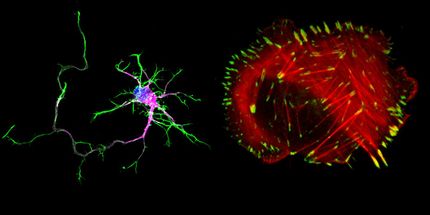Researchers discover genetic link between both types of ALS
Researchers from Northwestern University Feinberg School of Medicine have discovered a link between sporadic and familial forms of amyotrophic lateral sclerosis (ALS), a neurodegenerative disease also known as Lou Gehrig's disease.
Researchers found that a protein called FUS forms characteristic skein-like cytoplasmic inclusions in spinal motor neurons in most cases of ALS. Mutations in this gene have been previously linked to a small subset of familial ALS cases. Researchers thus linked a rare genetic cause to most cases of ALS, clearing the way for rational therapy based on a known molecular target. The study was published in the Annals of Neurology .
Some forms of familial ALS are caused by genetic mutations in specific genes. Mutations in the Cu/Zn superoxide dismutase gene (SOD1) account for approximately 20 percent of familial ALS cases. Mutations in the TAR DNA-binding protein gene (TDP43) and FUS gene occur in about 4 to 5 percent of the familial ALS cases. Altogether, mutations in specific genes have been identified in about 30 percent of familial ALS cases. In contrast to familial ALS, the etiology and the pathogenic mechanisms underlying sporadic ALS - 90 percent of all ALS - has remained largely unknown. Understanding the causes and pathogenic mechanisms of sporadic ALS is the major challenge in this disease.
For this study, researchers examined the post-mortem spinal cords and brains of 100 cases, 78 with ALS and 22 in a control group. They found FUS pathology in the spinal cords of all the ALS cases, except for a few cases with SOD1 mutations. But FUS pathology was not present in control cases without ALS.
"This is a game changer because it establishes a connection in the development of sporadic ALS with a known cause of familial ALS," said senior author Teepu Siddique, M.D., the Les Turner ALS Foundation/Herbert C. Wenske Professor of the Davee Department of Neurology and Clinical Neurosciences at Feinberg and a neurologist at Northwestern Memorial Hospital.
"Our finding opens up a new field of investigation for rational therapy for all of ALS," Siddique added. "This is the holy grail of researchers in this field."
"There hasn't been a therapy for most of ALS, because the cause was unknown," Siddique said. "Three genes have been identified in ALS, but the problem has been connecting inherited ALS to sporadic ALS." "We identified the FUS pathology in sporadic ALS and most familial ALS cases," said Han-Xiang Deng, M.D., associate professor of neurology at Feinberg and lead author of the paper. "The patients with the FUS pathology may account for about 90 percent of all ALS cases. Our findings suggest that pathological interaction of FUS with other proteins is a common theme in motor neuron degeneration in the vast majority of the ALS cases. We believe that this is a major step forward in formulating a common pathogenic pathway for motor neuron degeneration. Importantly, it may offer a novel avenue for developing therapies through targeting these FUS-containing inclusions." The one exception to the new finding is when familial ALS is associated with a mutation on the SOD1 gene. In those patients and in the mutant SOD1 transgenic mouse models, researchers did not find evidence of FUS pathology.
"This tells us that it follows a different pathway of pathogenesis, so treatment for this form of the disease would have to be different," Deng said.
Most read news
Topics
Organizations
Other news from the department science

Get the life science industry in your inbox
By submitting this form you agree that LUMITOS AG will send you the newsletter(s) selected above by email. Your data will not be passed on to third parties. Your data will be stored and processed in accordance with our data protection regulations. LUMITOS may contact you by email for the purpose of advertising or market and opinion surveys. You can revoke your consent at any time without giving reasons to LUMITOS AG, Ernst-Augustin-Str. 2, 12489 Berlin, Germany or by e-mail at revoke@lumitos.com with effect for the future. In addition, each email contains a link to unsubscribe from the corresponding newsletter.




















































